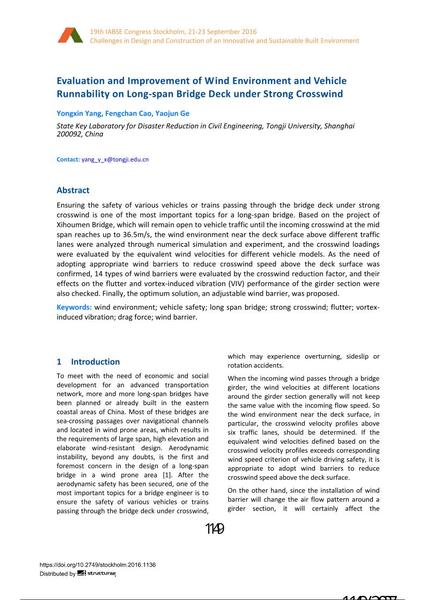Evaluation and Improvement of Wind Environment and Vehicle Runnability on Long-span Bridge Deck under Strong Crosswind

|
|
|||||||||||
Détails bibliographiques
| Auteur(s): |
Yongxin Yang
(State Key Laboratory for Disaster Reduction in Civil Engineering, Tongji University, Shanghai 200092, China)
Fengchan Cao (State Key Laboratory for Disaster Reduction in Civil Engineering, Tongji University, Shanghai 200092, China) Yaojun Ge (State Key Laboratory for Disaster Reduction in Civil Engineering, Tongji University, Shanghai 200092, China) |
||||
|---|---|---|---|---|---|
| Médium: | papier de conférence | ||||
| Langue(s): | anglais | ||||
| Conférence: | IABSE Congress: Challenges in Design and Construction of an Innovative and Sustainable Built Environment, Stockholm, Sweden, 21-23 September 2016 | ||||
| Publié dans: | IABSE Congress Stockholm, 2016 | ||||
|
|||||
| Page(s): | 1149-1156 | ||||
| Nombre total de pages (du PDF): | 8 | ||||
| Année: | 2016 | ||||
| DOI: | 10.2749/stockholm.2016.1136 | ||||
| Abstrait: |
Ensuring the safety of various vehicles or trains passing through the bridge deck under strong crosswind is one of the most important topics for a long-span bridge. Based on the project of Xihoumen Bridge, which will remain open to vehicle traffic until the incoming crosswind at the mid span reaches up to 36.5m/s, the wind environment near the deck surface above different traffic lanes were analyzed through numerical simulation and experiment, and the crosswind loadings were evaluated by the equivalent wind velocities for different vehicle models. As the need of adopting appropriate wind barriers to reduce crosswind speed above the deck surface was confirmed, 14 types of wind barriers were evaluated by the crosswind reduction factor, and their effects on the flutter and vortex-induced vibration (VIV) performance of the girder section were also checked. Finally, the optimum solution, an adjustable wind barrier, was proposed. |
||||
